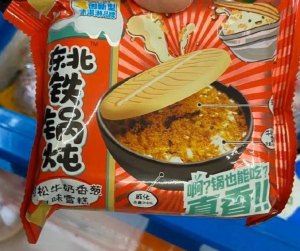Temperatures are rising rapidly in China and that is traditionally the signal for the ice cream industry to increase production. However, ice cream is one of the products the consumption of which has increased dramatically in the first quarter of 2020, when virtually all Chinese were confined to their homes with only very limited opportunities to go out. Convenient foods like instant noodles and snack food like nuts and seeds reported year-on-year increases up to more than 100%. The increase in ice cream consumption was less spectacular, but still 20% – 30%.
However, the most interesting development in the Chinese ice cream scene is not just the increase in consumption, but the growing interest in savoury flavours. Until recently, ice cream was typically a sweet to very sweet treat. Now, the most peculiar flavoured ice creams are appearing all over the country. Can you imagine enjoying scoop after delicious scoop of ice cream laced with: seaweed, shredded meat, onion rings, etc.? Curious? Go to China this summer to try them out, one by one. This development is so sudden and overwhelming, that I am not adding this news to my earlier post on ice cream, but dedicating a special post to it. This will not be a show window of who makes what. As usual, I will give you a good look into what is happening in this market.
Chives and shred meat
I have introduced shred meat or meat floss in an earlier post on Chinese meat products. I already noted there that it can be used as an ingredient in various foods. Here it is combined with chopped spring onions. If you can keep the taste of fresh spring onions, this combination might actually work very well with a suitable ice cream flavour.
Herbal tea
As noted in my post on Chinese drinks, I introduced herbal tea (often referred to as ice tea in Chinese) as a type of beverage derived from traditional Chinese medicine (TCM). It has become extremely popular in China during recent years, so why not make it into a popsicle? The design of the packaging reflects the ‘traditional’ nature of this product.
Hot and spicy
After my introduction, you undoubtedly expect a chili flavoured variety, so here it is. The packaging promises a lot of fire. I like chili chocolate (the mild type), so I expect to like this too.
Stinky toufu
Toufu, bean curd, is known very well in the Western world, as a versatile food ingredient and an alternative to meat. Stinky toufu doesn’t sound very nice, but refers to a kind of black fermented toufu that is fried and sold as a snack at street stalls in various parts of China. A traditional hot snack in winter is now also available as a cold snack in summer.
A cold hot pot
The last, but most spectacular, type that I want to introduce in this post is hot pot ice cream. Chinese love to eat hot pot, at home and in restaurants. You can throw almost any food in the boiling water, retrieve it when done, dip it in a sauce, and savour it. This ice cream comes in a pot, with a wafer a the lid, and laced with chopped vegetables and seaweed, topped with a layer of shred meat.
Fishy ice cream
Lidaju has designed what could be the weirdest type of savoury ice cream: fishy-flavored ice cream with bits of dried squid in it. This is someone I would only recommend to the seasoned lover of crazy foods. This is corroborated by the sub-text on the packaging feichang bu kede ‘very improper’.
There are more types and undoubtedly even more will appear. I may add the ones that I find most striking later.
Peter Peverelli is active in and with China since 1975 and regularly travels to the remotest corners of that vast nation. He is a co-author of a major book introducing the cultural drivers behind China’s economic success.


























